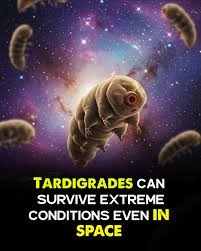Studying Tardigrades’ Space Survival and Resilience
Studying Tardigrades’ Space Survival and Resilience
Why in the News?
Indian astronaut Shubhanshu Shukla will conduct the Voyager Tardigrades Experiment aboard the ISS, focusing on how tardigrades, microscopic eight-legged creatures known for their extreme resilience, revive, survive, and reproduce in space conditions like radiation and microgravity. This study aims to understand tardigrades’ space survival capabilities.
What Are Tardigrades and Why They Matter?
- Tardigrades, or water bears, are tiny, aquatic micro-animals (~0.5 mm) with eight legs and clawed feet.
- They’ve existed for 600 million years, predating dinosaurs, and are known to survive all five major extinction events.
- They inhabit extreme environments—from mountain peaks to deep seas, and mossy patches (earning the name moss piglets).
- Scientists study them for their incredible resilience—withstanding extreme heat (150°C), cold (-272°C), UV radiation, and 40,000 kPa pressure.
Why Scientists Study Tardigrades in Space
- Tardigrades enter cryptobiosis and anhydrobiosis, reducing metabolism by 99.9% and water content by 96%.
- In this “tun” state, they survive harsh environments, including vacuum and radiation.
- They produce CAHS proteins, forming protective gel-like structures in cells—shielding DNA and vital components.
- These survival traits could aid crop improvement, tissue preservation, sun protection, and space medicine.
Voyager Tardigrades Experiment: Goals and Past Missions
- The ISS experiment revives tun-state tardigrades to study effects of microgravity and radiation.
- Aim: Identify genes responsible for resilience and DNA repair.
- Findings may help astronaut protection and space biology advancements.
- First space exposure: Foton-M3 mission (2007) proved tardigrades can survive and reproduce in open space, making them first animals to survive outer space without a spacecraft.
Key Facts About Tardigrades: |
|
● Tardigrades (Tardigrada) are microscopic, eight-legged invertebrates, also called water bears or moss piglets. |
|
● They belong to the phylum Tardigrada, with fossils dating back 90 million years (Cretaceous Period). |
|
● Molecular evidence suggests they originated at least 600 million years ago. |
|
● Capable of surviving extreme radiation, dehydration, starvation, subzero temperatures, and even space vacuum. |
|
● Thrive in harsh habitats: Arctic, deep seas, deserts, and moss-covered surfaces. |
|
● Survive via cryptobiosis, pausing metabolism under stress. |
|
● Possess the DODA1 gene that synthesizes betalains, antioxidants protecting cells from radiation damage and enabling recovery. |
The study of Tardigrades space survival capabilities continues to fascinate scientists and holds promise for various applications in space exploration and beyond.




